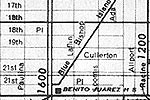
Lower
West Side
From the 1870s through the 1950s, the Lower West Side of Chicago
was a port of entry for thousands of Europeans: Irish, Bohemians,
Germans, Poles, Swedes, Slovaks, Slovenes, Lithuanians, Italians,
and Croatians. Today, the neighborhoods known as Pilsen, Heart
of Chicago, and Little Village form the center of Chicago's flourishing
Mexican community. Not only have Mexican newcomers revitalized
older ethnic institutions here, but they have established their
own businesses, restaurants, and social centers.
Throughout its history, the Lower West Side has been a relatively
isolated area, bounded by railroad tracks on the north and west
and by the South Branch of the Chicago River on the south and
east. Despite the fact that the Burlington Railroad linked this
part of the city to the downtown business district, the area developed
as a working-class neighborhood. Large manufacturing plants such
as the McCormick Reaper Works (later known as International Harvester)
and the Western Electric Company's Hawthorne Works in Cicero were
responsible for much of the growth of the Lower West Side, and
they reinforced its character as an industrial neighborhood.
Like the Back of the Yards district on Chicago's South Side,
Pilsen and its adjoining communities supported a wide range of
ethnic institutions and businesses. In addition to building homes
in the area, residents established churches and fraternal organizations
which met their special needs, first as immigrants and later as
second- and third-generation Americans. Home ownership set these
neighborhoods apart from the nearby Lawndale district, where families
rented apartments in multi-unit buildings. While social mobility
did occur in each of the area's ethnic groups, the Lower West
Side has remained a stable area. Just as Bohemians who settled
in Pilsen relocated further west as they moved up the economic
ladder, so Mexican families have also purchased homes, especially
in Heart of Chicago and Little Village. These latter neighborhoods
are in many respects "suburbs" of Pilsen, which continues
to be the port of entry for Spanish-speaking families from rural
Mexico and Texas.
1
of 13
next
»
|
 |

|
 |


Map
of the Lower West Side. »
|